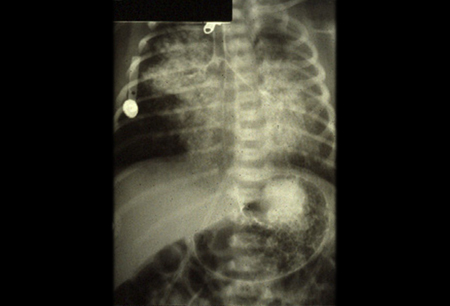Resumo
Definição
História e exame físico
Principais fatores diagnósticos
- tempo gasto na alimentação >30 minutos
- refeições estressantes
- deficit no crescimento (cruzando 2 percentis para baixo)
- recusa alimentar
- anormalidades craniofaciais
- avaliação de neurodesenvolvimento anormal
Outros fatores diagnósticos
- volume inadequado de alimentação
- vômitos
- dor abdominal, distensão ou cólica
- apneia, dessaturações e bradicardia em lactentes prematuros
- irritabilidade ou letargia durante a alimentação
- padrão de alimentação anormal na observação
- doenças subjacentes e internações prévias
- cirurgia gastrointestinal ou cardíaca prévia
- história familiar de atopia
- história familiar de problemas alimentares
- infecções pulmonares recorrentes e sibilo
- tosse ou esforço para vomitar durante as refeições
- alterações posturais durante a alimentação
- características atópicas
- evento com aparente risco de vida (ALTE)
- sialorreia
- anquiloglossia
- características de afecções genéticas
Fatores de risco
- prematuridade
- restrição do crescimento intrauterino
- atraso do desenvolvimento
- anormalidades anatômicas da orofaringe ou do trato gastrointestinal
- cirurgia gastrointestinal
- cirurgia cardíaca neonatal
- Síndrome de Down
Investigações diagnósticas
Investigações a serem consideradas
- exclusão temporária da proteína do leite de vaca
- estudo do pH esofágico por 24 horas
- estudo do trato gastrointestinal superior com contraste
- medida da impedância esofágica
- radiografia torácica
- videofluoroscopia da deglutição
- avaliação da deglutição por endoscopia de fibra óptica com teste sensorial
- endoscopia digestiva alta com biópsia
- exame radioalergoadsorvente (RAST) para proteína do leite de vaca
- tentativa de dieta sem lactose
- substâncias redutoras nas fezes
- anticorpos antitransglutaminase tecidual (tTG) e imunoglobulina A total
Algoritmo de tratamento
anormalidades anatômicas
distúrbios gastrointestinais
síndrome do intestino curto
comprometimento neurológico
prematuridade
distúrbios respiratórios
distúrbios cardíacos
problemas comportamentais
Colaboradores
Autores
Helen McElroy, MBChB, MSc, FRCPCH
Consultant Neonatologist
Medway NHS Foundation Trust
Gillingham
Kent
UK
Declarações
HM declares that she has no competing interests.
Agradecimentos
Dr Helen McElroy would like to gratefully acknowledge Dr Stephanie Gill and Dr Uma Sothinathan, previous contributors to this topic.
Declarações
SG and US declare that they have no competing interests.
Revisores
Alexander K.C. Leung, MBBS
Pediatric Consultant
Alberta Children's Hospital
University of Calgary
Alberta
Canada
Declarações
AKCL declares that he has no competing interests.
Sarah N. Taylor, MD
Assistant Professor
Division of Neonatology
Medical University of South Carolina
Children's Hospital
Charleston
SC
Declarações
SNT declares that she has no competing interests.
Créditos aos pareceristas
Os tópicos do BMJ Best Practice são constantemente atualizados, seguindo os desenvolvimentos das evidências e das diretrizes. Os pareceristas aqui listados revisaram o conteúdo pelo menos uma vez durante a história do tópico.
Declarações
As afiliações e declarações dos pareceristas referem--se ao momento da revisão.
Referências
Principais artigos
Rommel N, De Meyer AM, Feenstra L, et al. The complexity of feeding problems in 700 infants and young children presenting to a tertiary care institution. J Pediatr Gastroenterol Nutr. 2003 Jul;37(1):75-84. Resumo
Arvedson JC. Assessment of pediatric dysphagia and feeding disorders: clinical and instrumental approaches. Dev Disabil Res Rev. 2008;14(2):118-27. Resumo
Delaney AL, Arvedson JC. Development of swallowing and feeding: prenatal through first year of life. Dev Disabil Res Rev. 2008;14(2):105-17. Resumo
Artigos de referência
Uma lista completa das fontes referenciadas neste tópico está disponível para os usuários com acesso total ao BMJ Best Practice.

Diagnósticos diferenciais
- Refluxo gastroesofágico fisiológico
- Má rotação com volvo intermitente
- Intussuscepção intermitente
Mais Diagnósticos diferenciaisDiretrizes
- Identification and management of ankyloglossia and its effect on breastfeeding in infants: clinical report
- Gastro-oesophageal reflux disease in children and young people: diagnosis and management
Mais DiretrizesFolhetos informativos para os pacientes
Refluxo em bebês
Mais Folhetos informativos para os pacientesConectar-se ou assinar para acessar todo o BMJ Best Practice
O uso deste conteúdo está sujeito ao nosso aviso legal